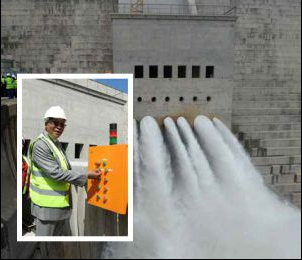De Hoop Dam gives hope to thousands
De Hoop Dam gives hope to thousands sadminWalking long distances through thorny bushes to access clean water will soon be a thing of the past for residents of Sekhukhune District, thanks to the opening of the De Hoop Dam.
 President Jacob Zuma recently opened the much-awaited De Hoop Dam, which will help address water problems in Limpopo.
President Jacob Zuma recently opened the much-awaited De Hoop Dam, which will help address water problems in Limpopo.
This fulfils the commitment made by the President in 2009, during his State of the Nation Address, when he said: “As long as there are communities without clean water or proper sanitation, we shall not rest”. In 2003, it was announced that a dam would be constructed in the Olifants River system to unlock the rich mineral deposits in Limpopo.
The sod-turning ceremony followed in 2007 and construction began, leading to the completion and opening of the project. The dam, costing more than R 3 billion, was built by the Department of Water Affairs to supply potable water to thousands of people in the Sekhukhune District.
De Hoop Dam, which is the 13th largest in the country, created more than 1 000 jobs. It is one of the key projects that fall under the umbrella of the Presidential Infrastructure Coordination Commission, which was established in 2012 to coordinate and fast-track infrastructure projects, under the leadership of President Zuma.
The dam will supply water to the towns, industries and poorly serviced rural communities in the Sekhukhune, Waterberg, and Capricorn Districts of Limpopo.
It will also supply water to the mines to help unlock vast mineral deposits, mainly in the form of platinum group metals found in the region. It will help spark both social and economic development for this region.
Progress
President Zuma said the dam confirmed the good story of the country - the story of development and progress that South Africa has achieved since 1994.
“The opening of this dam is yet another contribution to that drive of building a better South Africa through improving access to basic services and socio-economic infrastructure,” he said.
Millions of South Africans now have access to water, which they did not enjoy before 1994.
Access to a basic level of water increased from just over 60 per cent of households in 1994/95 to over 95 per cent of households in 2011/12.
“When we talk about this area being water stressed, we are talking about the plight of many people such as the unacceptable conditions of the people of GaMashabela near Jane Furse who struggle to access clean drinking water
“People still have to walk through thick and thorny bushes to reach the wells of Ntsoaneng GaKgari Mountains in order to access fresh water. Some of the residents still rely on borehole water which is insufficient to meet the demand of these communities,” the President said.
He also told the community that the pipeline from Jane Furse to Lobethal, which covers the villages of Ga-Mashabela, Diphagane, Ga-Phahla, Ga-Marishane, Tisane and Mamone, was 70 per cent complete, while a pipeline from Mooihoek to Tubatse was 100 per cent complete.
“The pipeline will provide water to the villages including Mandagshoek, Mashabela, Ntsoaneng, Driekop and River Cross. The bulk distribution system connected to the dam will ensure that over a period of time, all the people of this area will be served with an uninterrupted water supply, which is the ultimate goal of government.”
Water and Environmental Affairs Minister Edna Molewa said that government had launched a number of infrastructure projects throughout the country.
“It’s a good story. A project like this is for all of us to continue to work hard and support the President in his endeavour to fight poverty in this country,” said Minister Molewa.
Limpopo Premier Stanley Mathabatha said that through the opening of the dam, government had improved the lives of people in the province.
“Today is better than yesterday, we are certain that tomorrow, will be better than today,” he said.